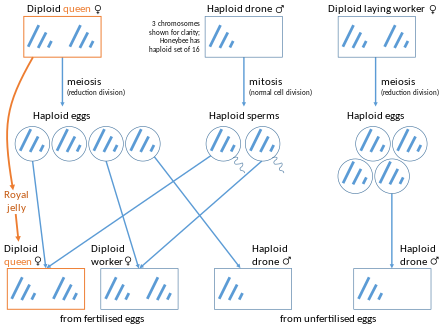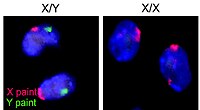
| Part of a series on |
| Sex |
|---|
 |
| Biological terms |
| Sexual reproduction |
| Sexuality |
| Sexual system |
Haplodiploidy is a sex-determination system in which males develop from unfertilized eggs and are haploid, and females develop from fertilized eggs and are diploid.[1] Haplodiploidy is sometimes called arrhenotoky.
Haplodiploidy determines the sex in all members of the insect orders Hymenoptera (bees, ants, and wasps)[2] and Thysanoptera ('thrips').[3] The system also occurs sporadically in some spider mites, Hemiptera, Coleoptera (bark beetles), and rotifers.
In this system, sex is determined by the number of sets of chromosomes an individual receives. An offspring formed from the union of a sperm and an egg develops as a female, and an unfertilized egg develops as a male. This means that the males have half the number of chromosomes that a female has, and are haploid.
The haplodiploid sex-determination system has a number of peculiarities. For example, a male has no father and cannot have sons, but he has a grandfather and can have grandsons. Additionally, if a eusocial-insect colony has only one queen, and she has only mated once, then the relatedness between workers (diploid females) in a hive or nest is 3⁄4. This means the workers in such monogamous single-queen colonies are significantly more closely related than in other sex determination systems where the relatedness of siblings is usually no more than 1⁄2. It is this point which drives the kin selection theory of how eusociality evolved.[4] Whether haplodiploidy did in fact pave the way for the evolution of eusociality is still a matter of debate.[5][6]
Another feature of the haplodiploidy system is that recessive lethal and deleterious alleles will be removed from the population rapidly because they will automatically be expressed in the males (dominant lethal and deleterious alleles are removed from the population every time they arise, as they kill any individual they arise in).[3]
Haplodiploidy is not the same thing as an X0 sex-determination system. In haplodiploidy, males receive one half of the chromosomes that females receive, including autosomes. In an X0 sex-determination system, males and females receive an equal number of autosomes, but when it comes to sex chromosomes, females will receive two X chromosomes while males will receive only a single X chromosome.
- ^ King, R.C.; Stansfield, W.D.; Mulligan, P.K. (2006). A dictionary of genetics (7th ed.). Oxford University Press. p. 194. ISBN 978-0-19-530761-0.
- ^ Grimaldi, D.; Engel M.S. (2005). The evolution of the insects. Cambridge University Press. p. 408. ISBN 978-0-521-82149-0.
- ^ a b White, Michael J.D. (1984). "Chromosomal mechanisms in animal reproduction". Bollettino di Zoologia. 51 (1–2): 1–23. doi:10.1080/11250008409439455. ISSN 0373-4137.
- ^ Grimaldi, D.; Engel M.S. (2005). The evolution of the insects. Cambridge University Press. p. 465. ISBN 978-0-521-82149-0.
- ^ Hughes, W.O.H.; et al. (2008). "Ancestral monogamy shows kin selection is key to the evolution of eusociality". Science. 320 (5880): 1213–1216. Bibcode:2008Sci...320.1213H. doi:10.1126/science.1156108. PMID 18511689. S2CID 20388889.
- ^ Edward O. Wilson (2005). "Kin Selection as the Key to Altruism: Its Rise and Fall". Social Research. 72 (1): 159–166. doi:10.1353/sor.2005.0012. JSTOR 40972006. S2CID 142713581.